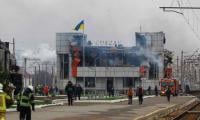As the late afternoon scorching sun across Karbala began to sink more than 1300 years ago, one of the last acts of Imam Hussain (a.s) on ‘Ashura’ deepened the impact of this unprecedented carnage for all times to come.
He laid down his six-month-old infant son Hazrat Ali Asghar (a.s) on the blistering sand of Karbala and stepped back with a plea to the army of Yazid ibne Muawiya for water for the severely dehydrated child.
His gesture was so powerful that it perturbed many among the soldiers of Yazid’s army, prompting Umar ibne Saad, the commander of the troops to order Hurmula an expert archer. “Discontinue (Imam) Hussain’s words”, yelled Saad while Hurmula took aim with a three-pronged arrow typically reserved for targeting horses and wild animals in battles. A moment later, the baby’s jugular was ripped apart, setting in motion an event that is well remembered to this day.
More than 1300 years later, the martyrdom of Hazrat Ali Asghar (a.s) will figure prominently among the remembrances on the 10th day of Muharram, as millions around the world gather to pay their homage to Imam Hussain (a.s) and other martyrs of Karbala. The count of at least 72 martyrs on that day includes the six-month-old infant, whose departure in a terrible way has no precedent in the history of Islam.
In Pakistan where ‘Ashura’ will be commemorated on Wednesday (July 17), this event will fuel gestures ranging from generous distribution of food for babies to charitable donations notably for children’s hospitals, water supply projects and other activities.
The strength of that tragic day lies monumentally in its rich remembrance despite the passage of time. Miraculous in its character, each day leading up to the 10th of Muharram and beyond continues to inspire generous activities all around.
This year’s special significance of the remembrance lies in it coinciding with the worst carnage being perpetrated by targeting unarmed people in a besieged and occupied strip of land. And the tragedy that continues to unfold in Indian-held Kashmir stands not too far behind, as a case of blatant bloodshed of innocent civilians.
As the sun went down in Karbala on that tragic day with the martyrdom of Imam Hussain (a.s) alongside his brother Hazrat Abbas (a.s), his son Hazrat Ali Akbar (a.s) and the infant Hazrat Ali Asghar (a.s), another tragedy was waiting to unfold in darkness.
After the soldiers of Yazid Ibne Muawiya had trampled upon the remains of the martyrs, riding the sturdiest among their horses, the troops raced to burn the tents of the women, children and the lone surviving adult male, Hazrat Imam Zainul Abideen (a.s), a son of Imam Hussain (a.s) who was ill and too frail to go into battle.
Several historical texts have cited the first decision by Imam Zainul Abideen (a.s) after he became the Imam and head of his household was to direct the women and children to escape to safety rather than go down with the burning tents. The attack on the camp of Imam Hussain (a.s) was the beginning of the unveiling of women after that tragic day. The events of that evening remembered as ‘Sham e Ghariban’ or the evening of the impoverished, additionally lay focus on Bibi Sakina (a.s), the four-year-old daughter of Imam Hussain (a.s). The invading troops pulled off her earrings leaving her bleeding profusely, before taking her among their prisoners.
The tragedy that unfolded after Ashura has no parallels in the history of Islam, especially involving the family of Prophet Muhammad (pbuh). The women who were captured after the men were martyred with Imam Hussain (a.s) were forcibly deprived of their veils and forced to ride on camels for a journey first to Kufa, the seat of Yazid’s appointed governor, Ubaidullah ibne Ziyad.
Before the carnage, Ziyad oversaw the first martyrdom of this terrible ordeal when he ordered the killing of Hazrat Muslim bin Aqeel, a first cousin of Imam Hussain (a.s).One of the many tragedies of this long journey to Kufa and eventually to Yazid’s court in Damascus was the practical failure of historians to agree with any reasonable certainty on the number of children who left Karbala against the number who survived till Damascus.
As this caravan raced to its destination many of the underaged children, according to historical accounts, simply fell off the backs of the camels, with Yazid’s troops showing no care to halt their advance to recover them.
In the period following the encounter at Karbala, the persona of Bibi Zainab (a.s), the younger sister of Imam Hussain (a.s) remains a towering example of defiance in the face of adversity. Her sermons, first at the court of Ziyad and subsequently in the presence of Yazid ibne Muawiya at the Umayyad mosque in Damascus, remain fine examples of unparalleled courage.
Citing from Surah Aal-e-Imran of the Holy Quran she recalled: “The disbelievers must not think that our respite is for their good We only give them time to let them increase their sins. For them there will be a humiliating torment”. Bibi Zainab (a.s) stood in captivity before Yazid ibne Muawiya and ridiculed him. At one point, she boldly intervened to stop Yazid ibne Muawiya from ordering the killing of Imam Zainul Abideen (a.s).
It is no less than a miracle that the survivors of Karbala were kept in a dungeon in Damascus for up to a year. But the carnage at Karbala still continued to widen its impact across the Islamic world. Slowly but surely, the martyrdom of Imam Hussain (a.s) began to provoke opposition to the rule of Yazid ibne Muawiya who died just three years later under unclear circumstances. Yet, his legacy failed to outlive him for long. His son and chosen successor, Muawiya ibne Yazid abdicated quickly on the grounds that he could not lead an empire that rests on the blood of the household of Prophet Muhammad (pbuh).
The remembrance of the tragedy at Karbala and afterward must serve as a lesson for all who live through tyranny, ranging from daily lives to overseeing small or large empires. Ameer Mukhtar e Saqafi, an Iraqi Muslim nobleman led a rebellion after Yazid ibne Muawiya died, and hunted down scores of individuals who participated in the carnage at Karbala.
Today, that history must serve a lesson to all despots – large or small -- that events will catch up with them sooner or later. Millions of mourners who join the gatherings in Karbala around the year do so only to remember Imam Hussain (a.s) and his followers.
Related large gatherings in Damascus around the final resting place of Bibi Zainab (a.s) only serve to reinforce her towering figure in the history of Islam. In sharp contrast, the Ummayad mosque in Damascus which served as the court of Yazid ibne Muawiya has become a point of popular pilgrimage mainly to pour scorn upon his rule.
Emaill: farhanbokhari@gmail.comThe writer is an
Islamabad-based journalist who writes on political and economic affairs.















